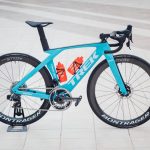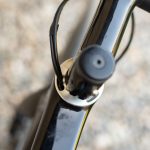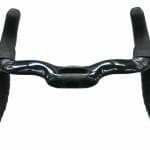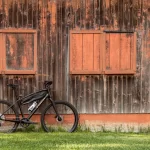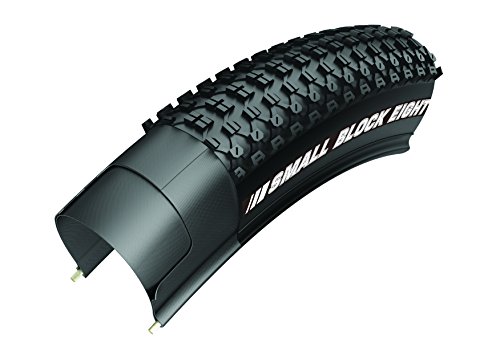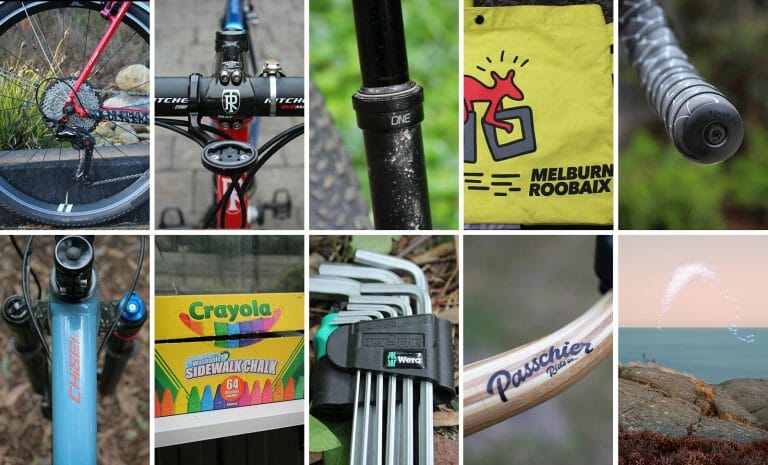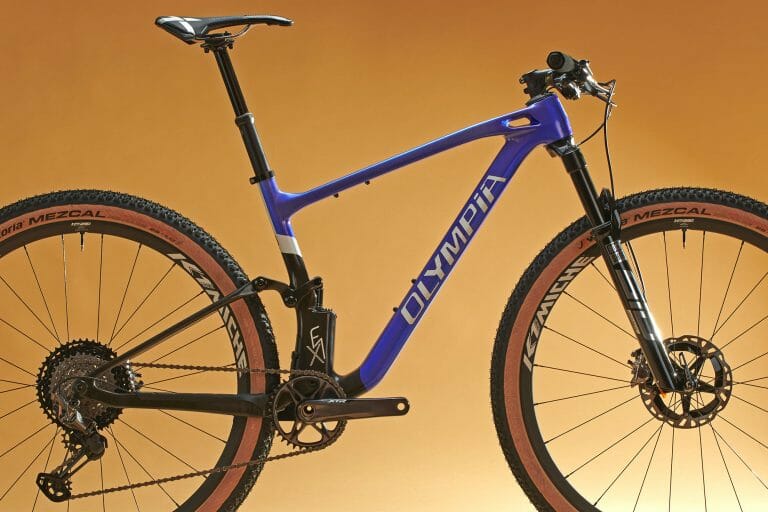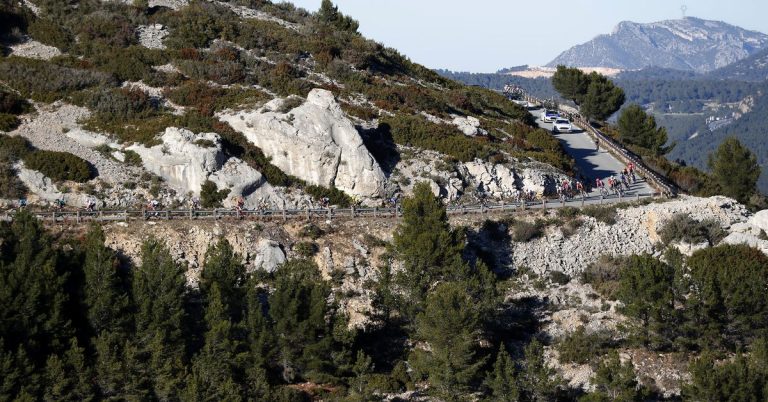2023 Trek Madone SLR long-term review
Story Highlights
- What it is:Trek’s latest take on its “ultimate race bike”: an aero race bike with striking design cues.
- Frame features:IsoFlow seat tube cutout, dramatically reduced weight, claimed 19-watt improvement over predecessor.
- Weight:7.4 kg (16.3 lb, actual weight, 56 cm size, without pedals).
- Price:US$13,200 / AU$18,000 / £13,800 / €15,000.
- Highs: Feels fast, light, responsive, and agile. Corners beautifully..
- Lows:Seriously expensive, IsoFlow equals spray flow, fit can be tricky.
It’s unclear if Groove Armada were actually singing about aero frames when they famously sang, “If everybody looked the same, we’d get tired of looking at each other.” I think it was a former colleague of mine, Dave Rome, who said the silhouettes of many aero frames are almost indistinguishable [Speak for yourselves, guys; I aced this quiz – James].
Someone at Trek is apparently a Groove Armada fan.
As many aero bike designers seemingly converge on similar concepts, Trek had other ideas. The latest Madone retains the aero theme but introduces a uniquely identifiable and radical new design concept in Isoflow – aka, “that hole in the seat tube”. There’s no mistaking the silhouette of this bike.
Trek officially announced the new Madone on the eve of the 2022 Tour de France. We hadn’t yet ridden the bike then, but our article covering that launch delved into all the updates and improvements Trek claimed the new Madone offers so feel free to head over there for a recap of all the nitty gritty details on the new bike. But having ridden the new Madone on and off for the better part of five months now, we now have a long-term review of this striking new aero rig.







Trek claims the Madone is the “ultimate race bike,” and first impressions of the new bike suggest they might have a point. The Madone is one of just a handful of bikes that have immediately felt like a tangible step forward on the first ride.
Given the sheer size of its aero tubing, 50 mm-deep rims, electronic groupset, and standard power meter, it feels lighter than the already relatively lightweight 7.4 kg it actually weighs. But aside from the lower weight, every tube, corner, and angle of the new frame, fork, and bar-stem is also designed to make the new Madone faster, lighter, and almost as compliant as the outgoing frame.
On the road, the new Madone feels fast, light, responsive, and agile, and it handles beautifully. That Isoflow seat tube hole is said to add compliance, and it seems to, even if it doesn’t quite match the older (and much heavier) Isospeed system for comfort. However, the Madone is still a race bike, and rides as such. If the Madone was a dance, it’s like a wiggle-your-butt rather than a shake-your-hips move over the cracked and poorly surfaced roads I mostly ride on. It’s a balance I like and the ride feels fast, regardless of how fast it actually is.





It’s a real eye-catcher, too. Rarely has a bike received as much attention as the new Trek. Riders and non-riding public alike commented both positively and negatively on its bold, chunky design. The Madone received the full spectrum of comments all the way from “that thing is insane” and “I love the paint job” to “what’s with the hole?”, “there’s no decals; is that still a prototype?” and the most frequent question, “is that an e-bike?”
The Madone might have speed and performance at the core of its “ultimate race bike” tagline, but in that moment, I couldn’t have cared less how aero, stiff, light, or aerodynamically efficient it is. It feels amazing, and for many riders, that’s plenty.
If I’d bought the new Madone purely for a good time, I’d have been a happy rider. As many of you will know, though, I always have at least one eye on maximising performance, and the new Madone threw up a few questions.

Questions like, why 25 mm clincher tyres? In an age when almost everybody is going wider, on a frame with ample clearance (even if officially clearance is limited to 28 mm), and on 30 mm-wide rims better suited to wider tyres, why has Trek opted for 25 mm as stock? The tan sidewall Bontrager R4s look fabulous and certainly aid with the weight reduction Trek had targeted for the new Madone, but I had to swap these out for 28 mm tyres.
You might want to upsize the tyres also, and that’ll come at an additional cost to what is already an expensive bike. Furthermore, you’ll also need to budget for tubeless rim tape as the product manager for the Madone is apparently on #teamtubeinside: the stock rim tape isn’t tubeless-compatible.
Then there is the fit. Everything else being equal, moving to a narrower handlebar reduces the effective reach to the levers and increases the rider’s torso angle. Despite this, Trek still fits a relatively short 100 mm stem on a 56 cm frame. As a result, many riders will end up in a more upright position that could possibly negate the aero gains of a narrower setup. Consider if you need a longer stem before ordering the frame and one-piece cockpit.




Fit aside, I found the new bar-stem combo remarkably comfort for such a performance-focused design. The tops are shallower and feel much more akin to a traditional round bar. There is a subtle flare to the drops for a wider position when getting low on the front. And Trek has incorporated an almost platform-like section just behind the hoods which proved perfect for resting my forearms on when riding in the “aero hoods” position (just don’t tell the UCI).
Lastly, on fit, I found my 75 cm saddle height is just about the minimum saddle height actually achievable with some saddles and the longer 200 mm seatpost supplied on my review bike. There is a shorter 150 mm seatpost worth considering if you, like me, run a lower than average saddle height for your height or frame size.
So about that hole
Finally, there was the question of Isoflow. It is a unique approach, and aesthetically, it has grown on me. I appreciate Trek is doing something unique, but inevitably, people will have questions as to why and what benefit there is to having a hole in the seat tube.
Trek says Isoflow offered the trifecta of reduced weight, improved compliance, and better aerodynamics. When the bike was launched, Trek explained how the Isoflow concept was initially the result of aerodynamic analysis and included for its aero gains. It was only later that Trek found the added benefits of reduced weight and improved compliance.

I can’t quantify exactly how much weight Isoflow offers on its own as compared to the much more complex IsoSpeed system on the previous-generation Madone. Given how the new seatstays now extend all the way to the top tube, and what appears to be an increase in the amount of carbon fibre material in the area, I can’t imagine the savings are huge. However, omitting IsoSpeed also eliminates a lot of that system’s hidden internal parts, and if you take Trek’s 300-gram overall claimed weight savings here at face value, it seems fair to assume the switch to Isoflow accounts for a decent chunk of that.
As mentioned earlier, Isoflow does offer improved ride compliance compared to what you’d expect for an aero frame with these sorts of tube cross-sections, but again, the Madone is a hard-core race bike, and it feels as such. It is not fair to expect it to feel like a Domane or any other endurance road bike. That said, the Isoflow Madone is amongst the comfier of aero-focused rigs I have had the pleasure of riding while blasting down country lanes.

So that just leaves the aero question. How much faster is having a hole in the seat tube? The answer is far from clear-cut. Before delving into any aero testing results, it is worth remembering while Trek’s headline 19-watt saving with the new Madone sounds huge – and it is – Trek also explained more than half those watts were found by helping the rider into a more aerodynamic position. The rider is always the largest drag contributor within the entire system, so while that makes the 19-watt figure a little misleading at first, I like that Trek at least recognises this and has also focused on improving the rider position instead of just the bike.
Trek attributes only around three of the remaining 10 watts or so of aero savings to Isoflow, with the remainder coming from the new Kammtail tubing, the aero bar tops, the new head tube, the taller bottom bracket area, and other frame features. Long story short, the Isoflow is just one small part of the entire aero upgrade package on the new Madone.
Furthermore, the seat tube is a notoriously tricky aerodynamic puzzle to solve. A rider’s legs generate a lot of turbulent airflow that can go anywhere and do anything. Trek claim the Isoflow hole channels the airflow into a low-pressure zone behind the frame, thereby reducing drag. That turbulent airflow may very well get channeled through the hole, but does it also reduce the turbulence? And what about the seatstays? The extra length mentioned above also doubles a single-seat tube’s surface area. Does that create more drag, and can the aero benefit of Isoflow outweigh that extra drag for an overall net improvement? Not only are these difficult questions to answer, but they are likely very condition-dependent. I have little doubt, given the right conditions, that Isoflow likely is faster. Trek tested the Isoflow at 45 km/h in a wind tunnel and using CFD, but I still wondered how it might compare in the real world.

To get an answer, I turned to Aerosensor and a piece of leftover foam used for packing bikes.
I shaped the piece of foam to mimic the shape of the seat tube, jamming into the Isoflow opening. Using the Aerosensor, I did a series of tests across several days assessing the Madone’s baseline drag over several out-and-back runs and compared that with test runs with the makeshift foam seat tube. The baseline and test run consisted of four repeats, each of a 2.4-km out-and-back route, alternating between baseline and test runs.
Long story short, the Madone tested marginally faster in every run with the foam insert partially closing the Isoflow opening. While it is not possible to extrapolate exactly how or why we see these results, one theory is that the foam offers a chance for the airflow to reattach and flow smoother into that space behind the frame. Another theory is the ~35 km/h speed of our repeats wasn’t fast enough to reflect Isoflow’s true potential.
On paper, our results are perplexing. Trek was quite open to hearing my test protocol and was happy to admit different tests may elicit different results. Furthermore, my testing simply compares two configurations of the same bike. It doesn’t compare the next Madone to the previous-generation bike or any other aero bike on the market, but the results are curious regardless, and only goes to further demonstrate the complexity of aerodynamic bike development.
Either way, an honourable aero mention goes to the Bontrager Aeolus RSL 51 wheelset, which repeatedly out-tested several other premium wheelsets – of either similar or taller section depth – using the same testing protocol.
Many riders and engineers expressed concerns about Isoflow’s structural rigidity when Trek unveiled the new concept. While I am no engineer, I have taken zero precautions and subjected the Madone to some severe hits going full-send down some of the worst roads Ireland has to offer. So far, there have been no zero indications of any forthcoming failures.
As I mentioned earlier, the new Madone feels phenomenally fast and provides one heck of a thrilling ride. Even considering the aero testing results, tricky fit, and humongous price tag, I’d gladly take the Madone racing seven days a week if it wasn’t for one minor issue that is could prove a deal breaker for me. It’s that hole in the seat tube, but not for any of the reasons mentioned above.


You see, I live in a rather soggy part of the world, and they say you don’t appreciate what you have until it’s gone. In this case, I didn’t appreciate before just how much rear tyre road spray is blocked by the seat tube, and with that Isoflow opening, my water bottle cap now fully exposed to it. It’s a similar case for the surprisingly vulnerable seatpost clamp area. I’d certainly like to see some sort of plug or cover there.
To flow or not to flow
For me, the new Madone’s real party trick is not the Isoflow, but that it offers all the aero tweaks and outright performance without compromising on day-to-day ridability. Beneath all its Isoflow openings, integrated one-piece handlebars, and oversized Kammtail tubing hides a normal bike with a threaded bottom bracket, easily adjustable stem and accessible (perhaps overly accessible) seatpost clamp. And while Isoflow may or may not provide an aero gain and reduce frame weight, it does provide enough ride compliance for what is still a pure race bike.
Minor quirks aside, Trek has produced a superb race bike. The new Madone is performant, a joy to ride, and unique. I applaud Trek for tackling rider aero drag and loading the new Madone with narrow bars; just remember to check the stem length before ordering.














